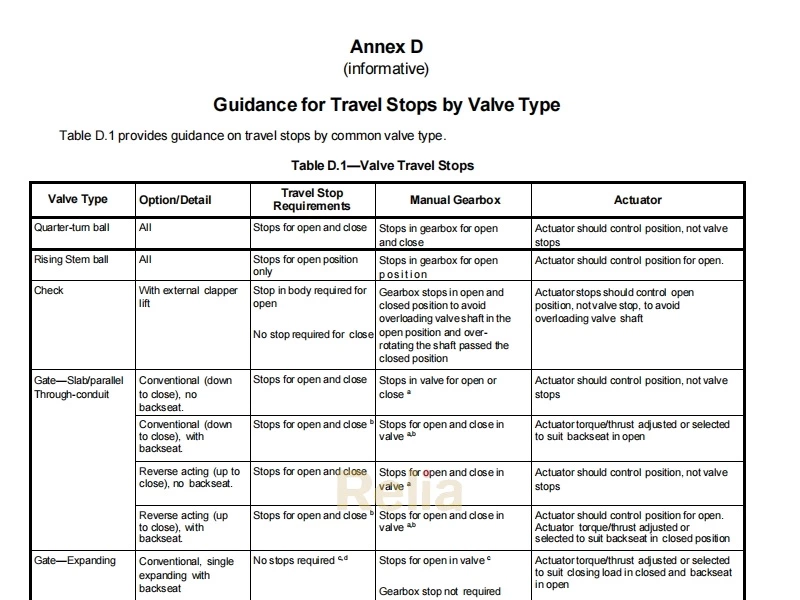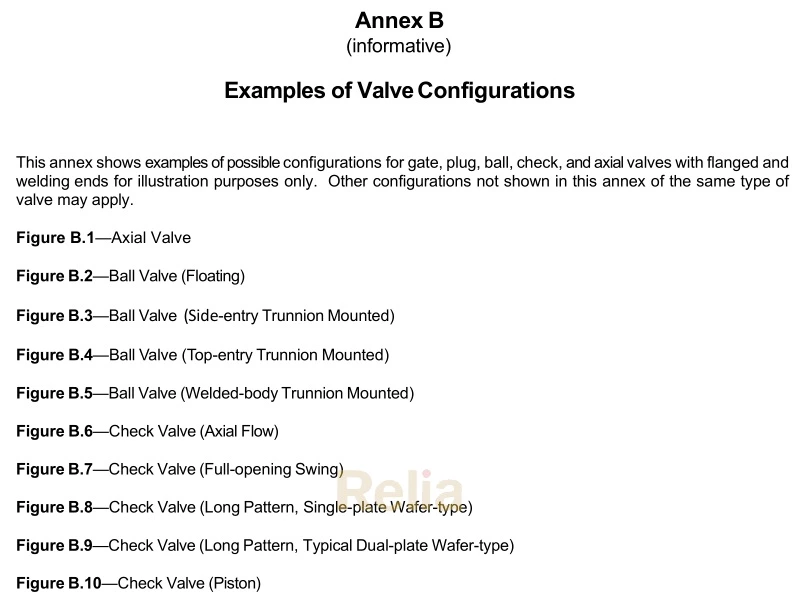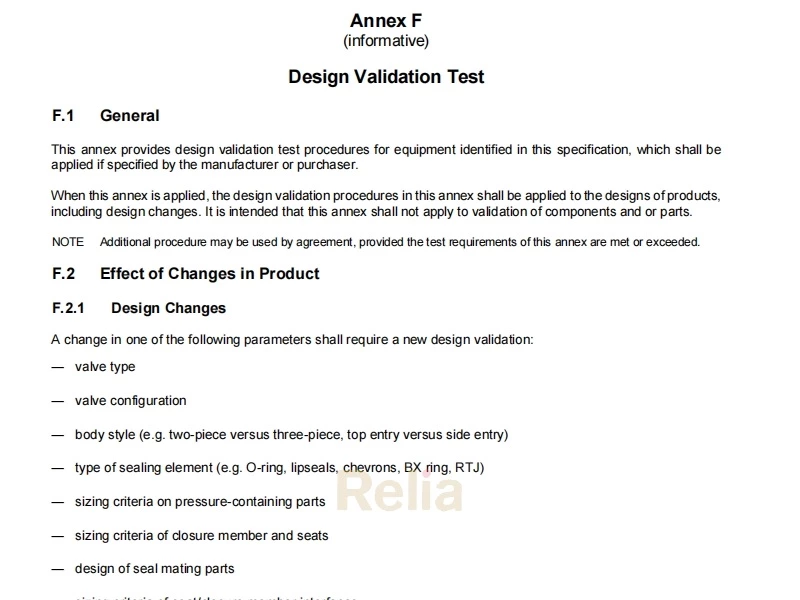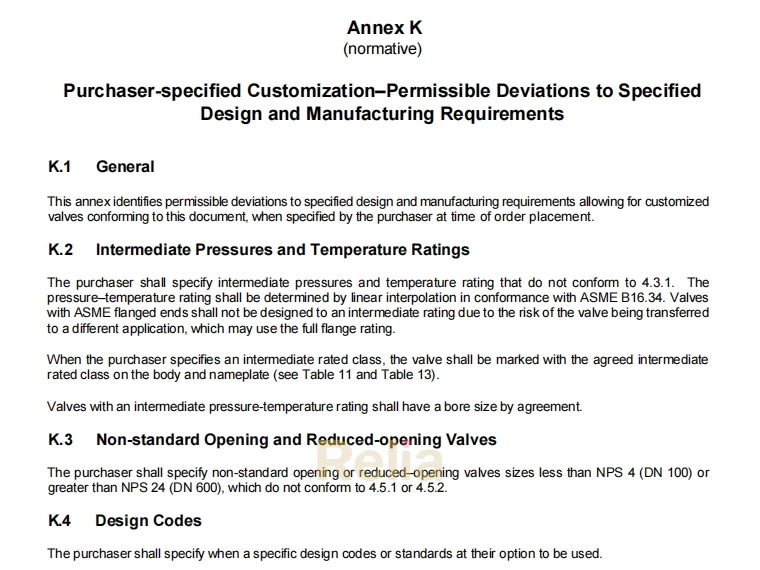API 6D Annex E
API 6D Annex E gives informative guidance on typical valve functions/features and is not intended to either be all-inclusive or restrictive.
Annex E
(informative)
Isolation Valve Features
E.1 Application of this Annex
Table E.1 is intended to give informative guidance on typical valve functions/features and is not intended to either be all-inclusive or restrictive. Individual valve designs exist that have unique sealing characteristics for which the table may not be appropriate or applicable. The user should take guidance from the manufacturer on establishing specific valve features.
Table E.1—Isolation Valve Types
| Valve Type | Sealing Arrangement | Block and Bleed | Double Block and Bleed | Double Isolation and Bleed | |
| Block: | Two Valves with Bleed Between | Any valves with bidirectional sealing | Yes | Yes | Yes |
| Trunnion Mounted Valve | Upstream sealing, pressure energized, self-relieving (Note 1) | Yes | (Note 4) | No (Note 5) | |
| Trunnion Mounted Valve DIB-1 | Upstream and downstream sealing, pressure energized, example, two bidirectional sealing seats (Note 1) | Yes | (Note 4) | (Note 6) | |
| Trunnion Mounted Valve DIB-2 | Upstream and downstream sealing, pressure energized, example, one bidirectional and one unidirectional sealing seat (Note 1) | Yes | (Note 4) | Only if bidirectional seat is on downstream side (Note 6) | |
| Floating Valve | Pressure energized | No (Note 2) | No | No | |
| Gate: | Gate: Slab and/or Through-conduit | Pressure energized—downstream sealing only/fixed seats (Note 1) | No (Note 2) | No | No |
| Slab and/or Through-conduit DIB-1 | Pressure energized—upstream and downstream sealing (Note 1) | Yes | Yes (Note 3) | Yes (Note 3) | |
| Expanding DIB-2 | Mechanically energized | Yes | Yes (Note 3) | Yes (Note 3) | |
| Plug: | Standard | Pressure energized, downstream sealing | No (Note 2) | No | No |
| Expanding DIB-1 | Mechanically energized | Yes | Yes | Yes | |
FOOTNOTES
NOTE 1 The terms “ upstream” and “ downstream” refer to the pressure source and open end/equipment respectively and do not refer to flow direction
NOTE 2 Not possible to bleed from valve body, but bleed may be in downstream pipework/pipeline
NOTE 3 Depending on detail design of the valve, some valves may have preferred sealing direction and/or a specified sequence of operation
NOTE 4 Depending on detailed design
NOTE 5 Downstream seat may provide a second barrier at pressures below the cavity relieving pressure barrier
NOTE 6 Depending on detailed design and ability to achieve testing per L.14, L15, L.16 or L.18
E.2 Description of Sketches
The user is responsible for ensuring the operational requirements are consistent with specific valve features including sealing capability and function.
The table and sketches are typical and intended to give definition of the terms “block and bleed” (Figure E.1 and Figure E.2), “double block and bleed” (Figure E.3 and Figure E.4), and “double isolation and bleed” (Figure E.5 and Figure E.6) in a single valve or double valve arrangement as defined by this specification. Other documents, including applicable federal regulations, may have a different definition of these terms.
BB may be achieved by a connection in the pipework/pipeline downstream of the block valve or from a connection on the valve body when the valve is an upstream seating type.

Figure E.1 - Block and Bleed-Type A

Figure E.2 - Block and Bleed-Type B.jpg
E.3 Double Block and Bleed (DBB)
The DBB feature of the valve or valves is the ability to segregate two pressure sources and to bleed/vent pressure in the void between the two sealing elements (blocks). The bleed may be in the pipework/pipeline when two valves are used, or in the valve body between the two seats when the valve has the DBB feature.

Figure E.3—Double Block and Bleed—Type A

Figure E.4—Double Block and Bleed—Type B
E.4 Double Isolation and Bleed (DIB)
The DIB feature of the valve or valves is the ability to provide two sealing elements to a single pressure source, and to bleed/vent between the two sealing elements. Note that some documents dealing with isolation of equipment may refer to this feature as double block and bleed.

Figure E.5—Double Isolation and Bleed—Type A

Figure E.6—Double Isolation and Bleed—Type B





